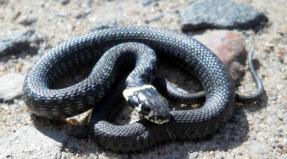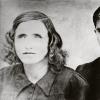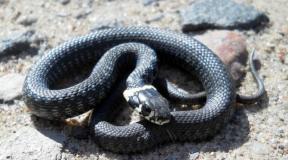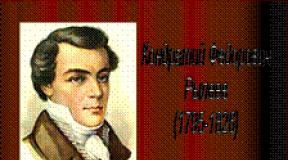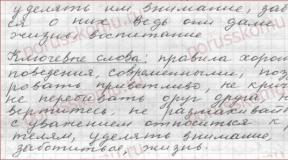Egor Petrovich Kovalevsky in East Africa. African researchers and their discoveries Yegor Kovalevsky discovered in Africa
Egor Petrovich Kovalevsky (1811 - 1868)
In 1847, E.P. Kovalevsky was sent by the Russian government to Egypt at the request of the Egyptian side to send an experienced mining engineer to continue the search for gold.
The route of Kovalevsky’s expedition followed the Nile, the Blue Nile and the Tumat River flowing into the Blue Nile (Fig. 2.3). From the city of Berbera to Khartoum, the expedition moved along the river, then along the Blue Nile to the village of Rosseros (Roseires). From here the walking route along the Tumat River began. The expedition of the Russian traveler ended with travels along the upper reaches of this river and to the west of them. On the way back, the route was almost completely repeated, with the exception of the section passing through the Great Nubian Desert (Fig. 2. .).
In the Tumat River basin, E.P. Kovalevsky discovered numerous placer gold deposits. The researcher did not limit himself to the task of gold exploration given to him. He sought to find out the location of the sources of the Nile. According to the prevailing opinion at that time, the Nile had to originate at the foot of the mountains located south of the Tumat River. But Kovalevsky, while exploring this area, did not discover the sources of the Nile. Moreover, he concluded that “this is physically impossible: from the northern slope of these mountains originate rivers flowing directly to the north, such as Yabus and even Tumat itself, which would certainly meet on the way with the White Nile if he was here, and would have merged with it, but meanwhile they safely reach their goal after a long journey to the north, i.e. flow into the Blue Nile..." Based on his personal observations, Kovalevsky concluded that the main river is not the Blue Nile, but the White Nile.
On the territory of Eastern Sudan, as in many other places along the route, E.P. Kovalevsky determined the latitude and made barometric measurements of altitudes. The indicators he presented were in many points much more accurate than the indicators given by earlier researchers. Based on his measurements, Kovalevsky compiled a map of the territory he studied (appendix). Analyzing this map, we can conclude that the researcher depicted river valleys in great detail, as well as many orographic objects, especially in the territory of modern Sudan and Ethiopia. The map also shows the main tribes inhabiting the area (eg Tuklawi, Futi). The type of activity of the population is also noted to some extent (for example, blacks processing iron ores). The settlements in the Nile Valley are shown in great detail.
Kovalevsky also carried out botanical observations. They were few in number, but the most important thing is that Yegor Petrovich made a detailed description of the Duleb palm tree, and also noted that thickets of tamarisks and acacias are typical for the Blue Nile Valley.
His ethnographic observations were of great value. The researcher opposed racism, as well as the enslavement of the indigenous population of Africa, considering blacks no less worthy people than representatives of other races.
The result of Kovalevsky's expedition was that it significantly clarified the geography of the Nile Valley. His geological observations were of great importance, representing the first attempt to give a summary of the geological structure of the Nile Valley. Having studied the geological structure of the river valley and its tributaries, Kovalevsky proved the gold content of the rocks in this area and organized gold mining at several industrial factories. Having established the construction of the factory, the traveler set off along the dry riverbed to the sources of Tumat in search of gold and the sources of the Nile. He found three gold-bearing placers, but plans to search for the sources of the Nile had to be abandoned because the traveler was overcome by an acute fever. Having recovered, Kovalevsky set off on the return journey and in 1848 arrived in Alexandria.
Yegor Petrovich's expedition was short-lived (late 1847 - first half of 1848), but its geographical results were significant. The materials collected during this expedition were presented by the researcher in the work “Travels to Inner Africa” (1849). This work contains geographical, ethnographic, historical and other information.
Egor Petrovich Kovalevsky
Russian writer...
Kovalevsky, Egor Petrovich - Russian writer, traveler, public figure. Born into a noble family. In 1825-1828 he studied at Kharkov University. In 1830 he went to Siberia, worked in the mines, studied gold deposits. Traveled throughout Central Asia, southern Europe, Africa, Eastern countries, etc. In 1855, he participated in the defense of Sevastopol. Since 1856 he settled in St. Petersburg. In 1856-1864 he was assistant to the chairman of the Geographical Society, then an honorary member. In the 40s, K. was friendly with the Petrashev poets A.I. Palm and S.F. Durov, in the late 40s and early 50s he became close to I.S. Turgenev, N.A. Nekrasov, N. G. Chernyshevsky, L. N. Tolstoy. He was one of the organizers and the first chairman of the Literary Fund. K. appeared in print as a poet. In 1832 he published a collection of poems “Siberia. Duma" and the historical tragedy in verse "Martha the Posadnitsa, or Slavic Wives." Turning to prose, K. published the novel “Petersburg Day and Night (1845), stories (“Majorsha” and others), travel essays: “Four Months in Montenegro” (1841), “Wanderer on Land and Seas” (ch . 1-3, 1843-1845), “Journey to Inner Africa” (1849), “Journey to China” (1853). K.'s articles on Africa and speeches in defense of blacks were met with sympathy by Nekrasov and Chernyshevsky. K.’s book “Count Bludov and His Time” (1866) aptly characterizes the events of the early 19th century and gives vivid portraits of historical figures. K.'s works are distinguished by observation, humane views, simplicity of language and humor. F.I. Tyutchev responded to K.’s death with poems, and M.E. Saltykov-Shchedrin wrote the obituary. The image of K. is captured in the historical novels by V. Sinenko “Mountain Captain” (1958) and “The Country of Ophir” (1960).
Brief literary encyclopedia in 9 volumes. State scientific publishing house "Soviet Encyclopedia", vol. 3, M., 1966.

In those years, Sakhalin was represented as a peninsula.
Diplomat...
Kovalevsky, Yegor Petrovich (1811-1868) - Russian diplomat, known for his activities in the Slavic states of South-Eastern Europe and the Far East. In 1837, Kovalevsky, as a mining engineer, visited Montenegro at the invitation of Peter Njegosi. Kovalevsky took part in one of the Austro-Montenegrin clashes on the border. Here he first showed his diplomatic skills and contributed to the rapid resolution of the conflict. After this, K. repeatedly carried out diplomatic assignments in the countries of South-Eastern Europe, and at the end of the 40s he went to the Far East. Accompanying the Russian spiritual mission to Peiping in 1849, Kovalevsky obtained permission from China to allow the mission to travel the shortest route, bypassing the Argalin sands, along which the Chinese had previously deliberately driven Russian caravans, hiding from them the direct road through Mongolia.
In 1851, Kovalevsky signed the Russian-Chinese, so-called Treaty of Kulja(...), who opened Dzungaria to Russian trade. In 1853, during the Turkish-Montenegrin War, Kovalevsky was sent to Montenegro as a Russian commissar. He contributed to the cessation of hostilities and the beginning of peace negotiations, which prevented the invasion of Montenegro by the army of Omer Pasha. In 1856, Kovalevsky Byt was appointed to the post of director of the Asian Department of the Ministry of Foreign Affairs. With his participation, the text was developed Aigun Treaty of 1858(....), according to which vast territories north of the Amur River were assigned to Russia.
Diplomatic Dictionary. Ch. ed. A. Ya. Vyshinsky and S. A. Lozovsky. M., 1948.

...and also a traveler
Kovalevsky Egor Petrovich - Russian traveler, diplomat and writer. For eight years (1857-1865) he was assistant to the chairman of the Russian Geographical Society, and from February 1865 - its honorary member. During his trip to Africa (1847-1848), he made a great contribution to the resolution of the “Nile problem”. Kovalevsky specialized in gold exploration and mining.
An unusual case brought Kovalevsky to Africa. The ruler of Egypt, Muhammad Ali, was obsessed with finding the mysterious country of Ophir. There, according to legend, treasures were mined for King Solomon and the Egyptian pharaohs. An ancient Arabic manuscript prompted Muhammad Ali to send people on a search to the distant region of Fazoglu. The envoys of the ruler of Egypt actually found gold deposits, but very scarce ones.
Then a message was sent to the Russian Tsar with a request to urgently send a knowledgeable mining engineer. This is how Kovalevsky ended up in Africa. Together with him, Siberian and Ural foreman and miners arrived in Egypt.
The route of Kovalevsky's expedition went mainly along the Nile, its tributary - the Blue Nile and the Tumat River flowing into the latter. From Alexandria to Cairo we traveled the usual route along the Mahmudiye Canal and the Rosetta Branch of the Nile Delta. Kovalevsky left Cairo on January 20, 1848. On the fifth day they were in Aswan, from where the voyage along the Nile continued on sailing barges - dahabiye. But they failed to pass through the rapids of the Nile above the city of Kurusku, so it was decided to go through the Great Nubian Desert along the caravan route.
Kovalevsky went deeper into the Great Nubian Desert, where, as he testifies, the hot air seemed purple. The caravan walked continuously for twelve to thirteen hours a day. Only on the tenth day of the journey the desert ended and the river welcomed travelers again. On barges they slowly moved towards the city of Khartoum, where the White Nile and Blue Nile, merging, give rise to the Nile proper.
Khartoum is the capital of Sennar and all of Eastern Sudan. Sennar - a region with a city of the same name - occupied the interfluve between the White and Blue Nile until their confluence at Khartoum, forming a triangle. Kovalevsky called this triangle the Sennar Peninsula. Meadows with herbs as tall as a man, lush steppes, virgin forests where the roar of a lion was heard - such was the appearance of this country. In the forests of Sennar, he discovered a new type of palm tree - duleb, and collected seeds and roots of useful plants.
Leaving the Blue Nile, the Russian detachment headed to the tributary of this river - Tumat. No one had been on the banks of the Tumat before Kovalevsky. He opened this country to science. The Tumat region in its geological structure and conditions of occurrence of gold-bearing rocks was reminiscent of Pyshma and Miass in the Urals. Russian geologists unerringly found gold in greenstones, in the hollows and tributaries of an African river.
The Ural experience, applied in distant Africa, was crowned with complete success. A Russian foreman discovered a rich gold mine. In the very heart of Africa, a processing plant for gold extraction was built following the model of Ural and Altai enterprises.
But Kovalevsky dreamed of a different kind of success. An Arabic proverb solved one of Africa's mysteries very simply: “The source of the Nile is in paradise.” By the time Kovalevsky traveled to Africa, they already knew that the Blue Nile began in Ethiopia. Before leaving Cairo, Kovalevsky heard that the travelers Abbadi brothers had finally managed to find the sources of the White Nile, and not far from the sources of the Blue Nile.
Kovalevsky found this strange. But if the Abbadi brothers are right, then along the dry bed of the Tumat River you can walk from the gold miners’ camp to the source of the great river! They tried in vain to dissuade the Russian from this idea, frightening him with a meeting with the warlike Abyssinian Galla tribe. Soon, Egyptian soldiers captured three highlanders, intending to turn them into slaves. Kovalevsky ordered the prisoners to be released. The rumor must have spread far and wide. Gaul was not touched by the aliens. The caravan passed unhindered to where weak springs gushed out from under the damp ground. None of Kovalevsky’s companions had ever seen where the Tumat River flows from. Before Kovalevsky's travels, the Upper Nile region was known only from the maps of cosmographers of the ancient world - Ptolemy (2nd century AD) and al-Idrisi (1154), but the maps compiled by them no longer met the needs of 19th-century geography.
To the south of the sources of Tumat lay a new country discovered by Kovalevsky. From the east it was limited by the peak of Fadasi, behind which the Abyssinian Highlands rose. The Moon Mountains rose at the southern border of the new country. How many legends have been written about the Moon Mountains, at the foot of which the sources of the Nile have been located since the time of Ptolemy! Kovalevsky rejected the erroneous statements of the ancients and believed that the sources of the Nile should not be sought here. It subsequently turned out that the Moon Mountains turned out to be the main mountain system of Inner Africa. Kovalevsky named the new country south of the Moon Mountains Nikolaevskaya. The Nevka River also appeared on his map.
Based on his personal observations, Kovalevsky concluded that the main river is not the Blue Nile, but the White Nile, and its sources should not be found between 3° and 10° N. sh., that is, in the places where the Moon Mountains were depicted on the map, and much further south...
The banks of the Nevka were the southernmost limit of Kovalevsky’s routes along the Sennar Peninsula. He reached the edge of the Abyssinian Highlands.
On the way back to Alexandria, in the Lesser Nubian Desert, Kovalevsky discovered the Abudom River, a left tributary of the Nile. This discovery refuted the opinions of the famous German geographers Humboldt and Ritter, who argued that the Nile has only one tributary - the Atbara River.
Kovalevsky's research brought some clarity to the orography of the western part of the Abyssinian Highlands. Eastern Sudan, or, as Kovalevsky called it, the Sennar Peninsula, a vast territory in the form of a triangle, enclosed between the lower reaches of the White and Blue Nile rivers, was put on the map by him according to his own observations. (This map is given as an appendix to Kovalevsky’s book “Journey to Inner Africa.”) Soon after returning from the campaign, he wrote the work “The Nile Basin Geologically and Gold Placers of Inner Africa.” And only much later - in 1872 - Kovalevsky’s book “Journey to Inner Africa” was published. This book contains information about the people and nature of countries unknown to Europeans. In it he points out the peculiarity of many rivers in this part of Africa. In the dry season, these rivers (even such significant ones as the Tumat, and especially small rivers - Nevka, Yabus) are dry riverbeds, but it is enough to dig a small depression in the riverbed to get good drinking water. Consequently, rivers flow under a layer of sand. During the rainy season, these rivers are full of water.
In 1849-1851, Kovalevsky traveled to China as a diplomatic representative. With his assistance, an agreement was signed under which Dzungaria was opened to Russian trade. The signing of the treaty greatly contributed to the geographical study of this part of Western China.
Site materials used http://100top.ru/encyclopedia/
Essays:
Collection soch., vol. 1-5, St. Petersburg, 1871-1872.
Literature:
[Saltykov-Shchedrin M.E.], E.P. Kovalevsky, “Notes of the Fatherland”, 1868, No. 10;
Annenkov P., E.P. Kovalevsky, St. Petersburg, 1868;
Panteleev L., E.P. Kovalevsky, first chairman of the Literary Fund Committee, in the book: Anniversary collection of the literary fund, St. Petersburg, 1909;
Kovalevsky P.M., Meetings on the path of life, in the book: Grigorovich D.V., Literary memoirs, L., 1928;
Valskaya B.A., Travels of E.P. Kovalevsky, M., 1956 (there is a bibliography).
EGOR PETROVICH KOVALEVSKY
Egor Petrovich Kovalevsky was born and educated in the Kharkov region. The date of his birth should be considered February 6, 1809 (although some sources call 1811).
Yegor Kovalevsky's father was a court councilor. The family was large and very friendly. Yegorushka (or, as his family called him, Gora) was the youngest child, and therefore everyone’s favorite. Unusually early, the boy aroused an interest in the world around him, since both his mother and his nanny told him a lot in childhood about Ukrainian nature, customs, and ancient legends.
In 1825, Yegor went to study in Kharkov, at the university founded in 1885 by his uncle, V.N. Karazin, with the active assistance of the elder Kovalevsky.
Yegor Kovalevsky was enrolled as a student at the Faculty of Philology in the department of moral and political sciences. He was also attracted to fiction.
During his student years, Kovalevsky wrote a tragedy in verse, “Martha the Posadnitsa of Novgorod, or Slavic Wives,” which was published in 1832.
However, most of all Gore loved the lectures on geography given by Professor P.P. Gulak-Artemovsky. These shallow in content, but extremely bright and fascinating lectures further strengthened Yegor Kovalevsky’s desire to devote his life to travel.
In 1829 E.P. Kovalevsky graduated from Kharkov University and left for St. Petersburg. There he became interested in geology and began attending lectures at the Mining Cadet Corps, worked a lot in the corps museum, and studied the practice of mining. In the department, he held the position of assistant clerk, but he did not like such clerical work, but practical field research attracted him.
Good abilities and hard work allowed Yegor Petrovich to acquire the specialty of a mining engineer in a fairly short time.
In 1830, Egor Petrovich, together with his older brother Evgraf, at that time a famous geologist, went to Altai, where Evgraf Petrovich was appointed head of the Altai mining district. At the end of 1830, the brothers arrived in Barnaul.
Soon, young Kovalevsky was appointed assistant to the manager of the office of the Chief Director of the Kolyvan-Voskresensky factories.
Egor Petrovich worked a lot with field parties and significantly enriched his knowledge of the geology of the Altai Territory. In 1831–1832, he led one of the geological expeditions to search for gold in Northern Altai.
Kovalevsky also had the opportunity to visit Ukraine. In February 1832, Yegor Petrovich accompanied a caravan with silver to St. Petersburg. From there he went to a foundry in Lugansk, where he became acquainted with coal mining techniques.
In January 1935, Kovalevsky, together with other geologists, “explored” gold in the valleys of the Oka and Irkut rivers. As a result of these works, an important study by Kovalevsky appeared on the mountainous terrain, geological structure, river network and permafrost soils of the visited areas.
In the same year, Yegor Petrovich Kovalevsky went to the Urals because his brother was transferred there. He settled in Zlatoust and from there made frequent trips throughout the ore-bearing Urals.
In 1836, the 27-year-old geologist received the rank of captain in the corps of mining engineers. Until 1837, he worked as a senior caretaker, bergmeister, and later, in 1846, he was appointed assistant to the head of the Zlatoust mining district and director of the arms factory.
In the spring of 1837, Kovalevsky returned to St. Petersburg, where he began preparations for a trip to Montenegro to search for gold. This small country was little known at that time. Books had not yet been written about it, and on maps it was then designated as Turkish Albania.
The Russian government allocated 16 thousand rubles for the organization and conduct of the expedition in Montenegro. The headquarters of the corps of mining engineers developed a special instruction for Kovalevsky, defining geological, geographical and statistical research. Kovalevsky passed through Warsaw, Krakow, Trieste, Vienna, Brno. From Trieste, he went on a small ship to the city of Kotor, and then he was on his way to Cetinje, the capital of Montenegro.
The first trip to Montenegro dates back to June 26, 1838. The caravan moved up the valley of the Rijeka River and reached the cave from which this river originates.
In the mountains, many surprises awaited travelers, for example, abysses and wells in which one or another rock could be distinguished. It was these rocks that Kovalevsky described personally, risking his life by descending by rope into the wells.
The weather was extremely hot, the temperature reached 40°. On the way we came across wretched villages, churches and monasteries.
Along the Ivan-Begovo-Chernoevich River, travelers went to Lake Skadar, which Kovalevsky subsequently described with great admiration: this lake was somewhat reminiscent of Baikal.
Kovalevsky did not stay long in Cetinje. From there he went to the village of Zagorazh. His route passed along the high and treeless Montenegrin plateau. Along the valley of the Zeta River there are fields, orchards and vineyards. But the living conditions of the local population were difficult.
A new trip to Montenegro took place in August 1838. This time Kovalevsky went to remote areas of Montenegro - Kuča and Morača. The traveler believed that this region was depicted on maps very inaccurately.
He saw many rivers and streams here, and lush vegetation grew around. The scientist also noted that the climate here is good, there are many animals in the forests, and fish in the rivers, but this area fenced off by mountains is characterized by wildness and poverty.
On August 14, 1938, Egor Petrovich Kovalevsky, having crossed Moraca, climbed Kom. There was amazing nature here too.
The weather improved, and a magnificent panorama opened up from the top of Kom: a significant part of Montenegro with mountain ranges and serpentine rivers was visible.
The journey ended in mid-September.
Kovalevsky actively searched for gold in Montenegro, but he found traces of the precious metal only on the Voruta River. And in karst caves, deposits of petroleum, one of the types of oil, were found. Egor Petrovich also compiled a geological map of Montenegro. He divided the territory of Montenegro into three physical-geographical regions (Montenegro Proper, Southern Montenegro, the districts of Moraca, Cuci and others) and gave a brief description of each region.
After Montenegro E.P. Kovalevsky began researching the nature, population and history of Central Asia long before Semenov-Tian-Shansky studied this area.
The Russian government sent Kovalevsky to Bukhara, since the Emir of Bukhara asked Russia to help him find gold, precious stones and ore.
Yegor Petrovich carefully prepared for the trip, having studied the works of his predecessors N.N. Muravyov, G. Meyendorff, E. Eversman and others.
A detachment of prospectors was assigned to the expedition of Orenburg Governor-General V.A. Perovsky.
Kovalevsky arrived in Orenburg in May 1839. The headquarters of the corps of mining engineers developed a program for him, according to which he was asked to study the natural conditions and mountain wealth of Bukhara and, at the same time, find out the possibilities of trade with the Bukhara Emirate and Afghanistan.
The government allocated the necessary equipment and 40 thousand rubles for this trip. The expedition began on October 30, 1839 and ended on March 11, 1840.
Initially, Kovalevsky explored the west of modern Kazakhstan, where the waterless steppes of the Southern Urals were located within the Ural basins with the tributaries of the Ilek, Emba, Irgiz and Kauljar.
The expedition crossed Mugodzhary and reached the Big Badgers desert.
Unfortunately, the expedition was prevented from reaching Bukhara by the Khivans, who simply captured the travelers. By the way, then the Khiva warriors were a real disaster for Russia. They robbed Russian traders and captured Russian citizens.
However, Yegor Petrovich Kovalevsky did not leave his job. He continued to study the climate, water resources and sparse vegetation of the Great Badger Desert. He was also interested in the state of nomadic cattle breeding in the northern Aral Sea region. However, while in captivity, the expedition's activities were very limited.
But Yegor Petrovich and his companions gradually prepared an escape. In two and a half days they walked 300 miles through deserted Ustyurt and reached the Ak-Bulak fortification. Kovalevsky took command of the garrison of this fortification and quite successfully repelled the onslaught of a large detachment of troops of the Khiva Khan.
Perovsky's detachment, which was actively preparing a campaign against Khiva, was unable to carry it out due to the harsh winter, and therefore returned to Orenburg. Kovalevsky also arrived here.
But, despite the failures, Yegor Petrovich was not going to give up visiting Bukhara. In March 1840, he went there again, this time through Tashkent, with a trade caravan from the city of Semipalatinsk.
The results of the research were new articles, rock collections and numerous herbariums.
In the Bakir-Tau mountains, Egor Petrovich Kovalevsky discovered deposits of iron and copper ores. But deep snow made the work of geologists very difficult.
Later, a geological description was compiled of the western part of the modern Kazakh SSR, bounded by the Ural, Emba, Ilek rivers, as well as the Mugodzhary, Aral and Caspian seas.
In August 1841, the traveler went to his native Yaroshevka for rest and treatment. In addition, he was engaged in literary processing of accumulated materials.
Yegor Petrovich devoted the next ten years to research in other regions of Asia, Europe and Africa. In 1851 he had to visit Central Asia, in particular China. Kovalevsky was sent to the city of Xinjiang on a diplomatic mission to achieve closer trade ties with the western provinces of China.
On the way, he mainly studied the basin of Lake Balkhash; the valleys of the rivers Ayaguz, Lepsy, Aksu, Karatal and others were also examined. Egor Petrovich was interested in the origin of groundwater in Southern Kazakhstan, the formation of runoff troughs and other forms of relief.
On this journey, Kovalevsky collected a fairly substantial collection of rocks and fossils, which he donated to the Museum of the Mining Institute.
Kovalevsky also visited Kashmir and Afghanistan, although the exact dates of these trips are not known.
While still in Gulja, Yegor Petrovich met the local feudal lord Yaksart Khan, who was a relative of the then ruler of Afghanistan. This khan told Yegor Petrovich a lot about India and about the terrible Kashmir earthquake that occurred in 1828, which he witnessed.
Naturally, Kovalevsky found time to visit Kashmir and Afghanistan. Subsequently, he wrote an essay on the 1828 Kashmir Earthquake.
In September 1843, Kovalevsky agreed with the proposal of the St. Petersburg Partnership to develop gold-bearing routes to explore the Balkans and Carpathians. A month later he left St. Petersburg. The years 1843–1844 were spent exploring the eastern part of the Transylvanian Alps. Kovalevsky crossed the Carpathian mountain system in several places, sometimes climbing some peaks. The picturesque nature of the Carpathians made a strong impression on the traveler.
In search of gold deposits, Kovalevsky explored the valleys of the Trakhov, Lotra and other rivers. In the areas he visited, he studied the geological structure and geological past, relief, climate, and vegetation of the area. Egor Petrovich is responsible for establishing a genetic connection between the Carpathians and the Balkans, separated by the narrow Kazan gorge, cut by the Danube.
E.P. Kovalevsky also wanted to visit Egypt. He repeatedly turned to the head of the Asian Department L.G. Senyavin with a request to go to Africa, but the latter always refused him.
Fortunately, chance helped Kovalevsky: Yegor Petrovich, together with the foreman Borodin and the gold panner Fomin, were sent to Egypt.
Preparations for the expedition went slowly. It was with great difficulty that we obtained money to purchase the necessary equipment. Kovalevsky spent a lot of time in the library, studying books on Africa.
According to the drawn up instructions, the expedition had two clear tasks: searching for gold and clarifying the location of the sources of the Nile. The journey itself lasted a little less than a year - until mid-1848.
The explorers sailed in November 1847 from Odessa to Greece. Along the way, they visited Constantinople, passed the Dardanelles, and visited Smyrna and Rhodes. In December the ship arrived in Alexandria. From there the expedition headed to Cairo, which Kovalevsky really liked.
On January 20, 1848, travelers set off from Cairo for Aswan. Soon they reached the Great Nubian Desert, along which they reached the city of Berbera. Kovalevsky figuratively called the desert “the dead grave of nature.” In his diary he wrote the following: “The desert appeared in all the horror of destruction and death. The carcasses of camels and bulls came across every ten steps, sometimes more often. Not a worm, not a fly, not a dried blade of grass: as if there had never been life here. Low-lying, isolated, scattered, half-covered mountains with sand had an absolutely striking resemblance to graves. Situated on a vast sandy plain, they gave it the appearance of a cemetery.
The sky is as empty as the earth... I have never seen anything more terrible in my life. The sun was burning: the heat reached 42.5°C, and in the space of ten days’ journey there was only one place with water, and it was so bitterly salty that only bondage forces you to drink it.” Kovalevsky wrote the following about the taste of this water: “Put two tablespoons of swamp mud in a glass of clean water, add salt and a piece of rotten egg. If you infuse all this with wormwood, you will get water in every way similar to the one we drank...” So you can imagine in what terrible conditions the travelers walked through the Nubian Desert.
However, in the desert, although it was rare, there were rains, and then the sandy mountains were covered with greenery. But the merciless sun quickly returned their joyless appearance.
The ordeal along the way did not prevent the travelers from carrying out a series of observations: determining the height of the area, conducting geological and meteorological observations.
Kovalevsky made his last three trips to China. Subsequently, he began writing scientific books and articles. His main work is considered to be the multi-volume work “Wanderer on Land and Seas,” where Kovalevsky described all his impressions of his travels.
Reviews about “The Wanderer” were positive not only from other travelers. The famous critic V.G. published his review of this work in the journal Otechestvennye zapiski. Belinsky.
In the summer of 1868, Kovalevsky went to Germany for treatment and improve his health. However, upon returning to his homeland, he fell ill again, this time the doctors did not hope for recovery.
From the book I'm from Odessa! Hello! author Sichkin Boris MikhailovichKOVALEVSKY Kovalevsky was about fifty years old. He was as helpful as a dog. All the teeth in his mouth were iron. They were inserted for him by a dentist-jeweler in Kyiv. He did it in such a way that Kovalevsky’s mouth did not close, and therefore his diction was completely impaired. When Kovalevsky
From the book I Don't Believe in Anarchy (Collection of Articles) author Letov EgorEGOR and GO Yegor is different from the Pig, that is, Andryusha Panov, in all respects. What Pig cannot explain even after a heavy drinking session, Yegorushka lays it out like two and two, and one even becomes ashamed: how can one not know this, much less notice it? However, behind the wondrous gift
From the book Memoirs of Contemporaries about A.P. Chekhov author Chekhov Anton PavlovichEGOR AND THE COMMUNICATES Instead of the epigraph: “On our side is all the best in Russian and Soviet art - from Dostoevsky to Mayakovsky, from Zinoviev to Letov, and on theirs?” (From the pre-election special issue of “Soviet Russia for Youth”) Egor Letov and his group CIVIL
From the book Great Tyumen Encyclopedia (About Tyumen and its Tyumen people) author Nemirov Miroslav MaratovichM. M. KOVALEVSKY - ABOUT A. P. CHEKHOV I was introduced to A. P. Chekhov by an old friend, editor of Russian Vedomosti V. M. Sobolevsky. I lived at that time in the vicinity of Nice, in the village of Beaulieu. Chekhov was recommended the southern climate. After spending some time in Biarritz, he and
From the book by A. S. Ter-Oganyan: Life, Fate and Contemporary Art author Nemirov Miroslav MaratovichLetov, Egor The most important lover of Yegor Letov and his work known to the author of these lines is Alexey Mikhailov; that’s why his messages about him: 1. How E. Letov and his “Civil Defense” were first seen by Mikhailov on the stage of the Neftyanik cultural center, and what
From the book Igor Talkov. Poems and songs author Talkova TatyanaLetov, Egor - This Letov of yours, what kind of communist is he? - A.S. Ter-Oganyan asks me. in the mid-1990s. “Well, firstly, Letov is not mine at all, I was never friends with him, I considered his music a surrogate, and, of course, I despise his political delights in every possible way,” I answer. - But
From the book Mikhail Gorbachev. Life before the Kremlin. authorGRANDFATHER EGOR Dreams, dreams! Where is your sweetness? A. S. Pushkin
From the book The Most Closed People. From Lenin to Gorbachev: Encyclopedia of Biographies author Zenkovich Nikolay Alexandrovich“Nimble Egor” I would like to make a significant reservation: to me personally, I emphasize these words - to me personally - Egor Kuzmich is very likeable. I often meet him in the State Duma, where he became a deputy in 1999, and we exchange pleasantries. He spoke well of my book “Central Committee
From the book The Path to Chekhov author Gromov Mikhail PetrovichSTROEV Egor Semenovich (02/25/1937). Member of the Politburo of the CPSU Central Committee from July 13, 1990 to August 23, 1991. Secretary of the CPSU Central Committee from September 20, 1989 to August 23, 1991. Member of the CPSU Central Committee since 1986. Member of the CPSU from 1958 to August 1991. Born in the village of Dudkino (now Stroevo) in the Khotynetsky district of the Oryol region in a rural family
From the book Selected Works author Vatsuro Vadim ErazmovichKovalevsky Maxim Maksimovich (1851–1916) Professor at Moscow University, lawyer, sociologist, historian. In 1887 he was suspended from teaching and dismissed from the university for freethinking. Lived in France; in 1901 he founded the Higher Russian School of Social Sciences in Paris. WITH
From the book by S. Mikhalkov. The most important giant author Biographies and memoirs Team of authors -- From the book by Yank Diaghilev. The water will come (Collection of articles) author Dyagileva Yana StanislavovnaEgor Mikhalkov-Konchalovsky Interview conducted by Vitaly Maksimov When did you begin to understand who your grandfather is? To be honest, probably when I was old enough. When I was born, it was 66, my grandfather was still not a very old man, but already gray-haired, with a mustache, in a gray jacket and with a Star
From the book In Literary Intelligence author Shmakov Alexander AndreevichNICK, EGOR, YANKA... ...In the tone studio "Devil's Wheel" Nick Rock 'n' Roll and his group KOBA worked on the album The Late Men. With the help of Natasha Greshishcheva, I found Nick, whom I had not seen for a year, and brought him to the Radio Russia studio. In the fragment published below, a large
From the author's bookfrom the article: EGOR AND GO...Egor respected Yanka. This would be an excellent tandem if Yanka remained alive. The Yankee music, painfully sincere, was in tune with what Egor did with GO. But Yanka left, and it is unlikely that anything like their short-lived duet will grow in this world. And Yegor wanders alone
From the author's bookEGOR LETOV ABOUT YANK from an interview: PUNK IN HIS CIRCLE A.: What prospects do you see next for your group? E.: I’ll come and record a new album. Now I have recruited a new team. Yanka writes lyrics and plays bass and guitar, she plays bass quite well, which is surprising. A.: And
In this article we will remember what contributions African researchers made to the development of geography. And their discoveries completely changed the idea of the Dark Continent.
First explorations of Africa
The first known trip around was made back in 600 BC. e. explorers of Ancient Egypt on the orders of Pharaoh Necho. The pioneers of Africa circumnavigated the continent and discovered previously unexplored lands.
And in the Middle Ages, this part of the world began to attract serious interest from Europe, which conducted active trade with the Turks, who resold Chinese and Indian goods at huge prices. This prompted European sailors to try to find their own route to India and China in order to eliminate the mediation of the Turks.
African explorers appeared, and their discoveries significantly influenced world history. The first expedition was organized by the Portuguese Prince Henry. During the first voyages, sailors discovered Cape Boyador, which is located on the west coast of Africa. The researchers decided that this was the southern point of the mainland. Modern scientists believe that the Portuguese were simply afraid of the dark-skinned aborigines. Europeans believed that the sun hung so low over the new land that the locals were burned black.
The Portuguese king Juan II equipped a new expedition, led by Bartolomeo Diaz, and in 1487 the Cape of Good Hope was discovered - the real southern point of the mainland. This discovery helped Europeans pave the way to the eastern countries. In 1497-1499 Vasco Da Gama was the first to reach India and return to Portugal.
The “African Researchers” table below will help you systematize your knowledge.

After this discovery, Europeans poured into Africa. In the 16th century, the slave trade began, and by the 17th, most of the territories of the black continent were captured and colonized. Only Liberia and Ethiopia retained their freedom. In the 19th century, active exploration of Africa began.
David Livingston

The scientist also explored Lake Ngami, described the Bushmen, Bakalahari and Makololo tribes, and also discovered Lake Dilolo, the western drain of which feeds the Congo, and the eastern drain feeds the Zambezi. In 1855, a huge waterfall was discovered, which was named after the British Queen Victoria. Livingston became very ill and disappeared for some time. He was discovered by explorer Henry Morton Stanley, and together they explored Lake Tanganyika.
The researcher devoted most of his life to Africa, was a missionary and humanist, and tried to stop the slave trade. The scientist died during one of the expeditions.
Mungo Park
Mungo Park undertook two expeditions to the Dark Continent. His goal was to explore western Africa, mainly its interior, its origins and Sinegal. Also a desirable goal was to establish the exact location of the city of Timbuktu, which Europeans had only heard about from local residents until that moment.
The expedition was sponsored by Joseph Banks, who participated in James Cook's first voyage. The budget was quite modest - only 200 pounds.
The first expedition was undertaken in 1795. It began at the mouth of the Gambia, where there were already English settlements. From one of them, the researcher and three assistants went up the Gambia. In Pisania he was forced to stop for 2 months because he fell ill with malaria.

He later traveled further up the Gambia and its tributary, the Neriko, along the southern border of the Sahara, where he was captured. A few months later, the scientist managed to escape and reach the Niger River. Here he made a discovery - Niger is not the source of Gambia and Senegal, although before this the Europeans believed that it was divided. The researcher travels around Niger for some time, but falls ill again and returns to the mouth of the Gambia.
The second expedition was better equipped and involved 40 people. The goal was to explore the Niger River. However, the trip was unsuccessful. Due to illness and clashes with local residents, only 11 people were able to reach Bamako alive. Park continued the expedition, but before sailing he sent all his notes with an assistant. African explorers are not always able to return home from dangerous places. Park died near the city of Busa while fleeing from local residents.
Henry Morton Stanley
English explorer of Africa Henry Morton Stanley is a famous traveler and journalist. He went in search of the missing Livingstone, accompanied by a detachment of natives, and found him seriously ill at Ujiji. Stanley brought medicine with him, and Livingston soon began to recover. Together they explored the northern coast of Tanganyika. In 1872 he returned to Zanzibar and wrote the famous book How I Found Livingstone. In 1875, accompanied by a large group, the scientist reached Lake Ukerewe.

In 1876, with a force of 2,000 men, equipped by the king of Uganda, Henry Morton Stanley made a great journey, corrected the map of Lake Tanganyika, discovered Lake Albert-Edouard, reached Nyangwe, explored the Lualabe River and completed the expedition at the mouth of the river. Thus, he crossed the mainland with east to west. The scientist described the journey in the book “Across the Dark Continent.”
Vasily Junker
Russian explorers of Africa made a great contribution to the study of the Black Continent. Vasily Junker is considered one of the largest explorers of the Upper Nile and the northern part of the Congo Basin. He began his journey in Tunisia, where he studied Arabic. The scientist chose equatorial and eastern Africa as the object of the study. Traveled along the rivers Baraka, Sobat, Rol, Jut, Tonji. Visited the countries of Mitta and Kalika.

Junker not only collected a rare collection of flora and fauna. His cartographic research was accurate, he compiled the first map of the upper Nile, the scientist also described the flora and fauna, especially the great apes, and discovered an unknown animal - the six-winged bird. The ethnographic data collected by Juncker is also valuable. He compiled dictionaries of black tribes and collected a rich ethnographic collection.
Egor Kovalevsky

African explorers arrived on the continent at the invitation of local authorities. Yegor Petrovich Kovalevsky was asked to come to Egypt by the local viceroy. The scientist conducted various geological studies in northeast Africa and discovered alluvial gold deposits. He was one of the first to indicate the position of the source of the White Nile, explored in detail and compiled a map of the large territory of Sudan and Abyssinia, and described the life of the peoples of Africa.
Alexander Eliseev
Alexander Vasilyevich Eliseev spent several years on the continent, from 1881 to 1893. He explored northern and northeastern Africa. He described in detail the population and nature of Tunisia, the Red Sea coast and the lower Nile.
Nikolay Vavilov
Soviet explorers of Africa often visited the Dark Continent, but Nikolai Ivanovich Vavilov stands out most among them. In 1926, he made a most important expedition for science. He explored Algeria, the Biskra oasis in the Sahara desert, the mountainous region of Kabylia, Morocco, Tunisia, Somalia, Egypt, Ethiopia and Eritrea.

The botanist was primarily interested in the centers of origin of cultivated plants. He devoted a lot of time to Ethiopia, where he collected more than six thousand specimens of cultivated plants and found about 250 species of wheat. In addition, a lot of information was obtained about wild flora.
Nikolai Vavilov traveled all over the world, researching and collecting plants. He wrote the book “Five Continents” about his travels.
An engineer and diplomat, he turned out to be the first Russian “specialist” in Africa, who provided invaluable assistance to her.
The possibility of an expedition to Africa arose in 1846, when two Egyptian engineers came to Russia “to get acquainted with the organization of the gold mining industry.” Kovalevsky accompanied them on a trip to the Urals. It was there that a plan arose - to send a Russian engineering mission to Sudan, which in those years belonged to Egypt... By the end of 1847, the expedition was already in Cairo.
The Nile, the greatest of the rivers of Africa, one of the deepest rivers in the world, the sources of which have not yet been discovered. A paddle steamer flying a green Egyptian flag moves noisily but slowly up the river. Finally, Aswan, the southernmost city of Egypt, appeared. Here the expedition transfers to dahabiyas - Nile barges, little changed since they transported stone blocks and statues for the temples of the pharaonic era. On dahabiyas, travelers climb up the river from the first rapids. Nubia begins - the gateway to Tropical Africa.
The expedition stops in the town of Korosko. Here the Nile turns sharply to the west and two caravan routes lead to it. Kovalevsky’s detachment unloads ashore and equips a caravan, in which there are about a hundred camels alone. The water in the waterskins became completely disgusting in taste and smell. The heat is stifling, but the Ababde walk briskly. “Is it hot? It's still winter, although it's ending. Either it will be in the summer!”
Near the town of Abu Hamed, the caravan reached the banks of the Nile. Further, over the bank of the great river, the caravan moved south and four days later arrived in the town of Berber, where the expedition again transferred to the Dahabiya and, with a fair wind, reached Khartoum on February 20. And here is Sennar - a town consisting of shacks, with barely 25 thousand inhabitants; a quarter of a century ago it was the capital of the powerful Fung Sultanate, which extended its power over most of Sudan. The Turks destroyed the sultanate, burned and plundered the city, and moved the capital to Khartoum. Sennar, which had a population of one hundred thousand in its best times, remained a minor provincial town.
The steppe vegetation is replaced by a damp gallery forest - thickets of reeds, trees, intertwined with vines, teeming with wild animals, birds, and snakes. From the shore you can hear the roar of lions, the cries of monkeys, the roar of hippos, the laughter of hyenas.
Finally, the flotilla of barges reached the town of Rosseires, where the path was blocked by another rapid. Having again loaded their equipment onto pack animals, the expedition moved to the foot of the Kossana Mountains - the final destination of the journey. In the town of Keri, Kovalevsky inspected a huge warehouse of equipment for gold mining, created by order of the Egyptian Khedive Muhammad Ali. The engineering mission was to find industrial deposits of gold, build a factory for washing and purifying it, and organize mining. In a short time, she completed her task, and the remaining intact and unstolen supplies from the government warehouse in Keri were put into action. Egyptian engineers Muhammad-Ali and Deshuri, who at one time had an internship in the Urals, together with Kovalevsky and Russian craftsmen, successfully managed the first gold-washing factory in Tropical Africa.
Although work on the construction of the factory was carried out day and night, E.P. Kovalevsky found time to conduct various scientific research. He hatches a plan to make an expedition to the upper reaches of the Tumat River, where no European has ever set foot. The “Turkish” ruler of the region resisted this idea of his restless guest for a long time, but in the end agreed to provide guards and guides.
On March 13, a detachment of over 1 thousand soldiers set out on a campaign. Along the way, Kovalevsky carried out geological and geographical surveys, ethnographic observations and, by the way, discovered a new gold-bearing area. The traveler became increasingly convinced that the sources of the Nile were incorrectly marked on the maps. Now he could substantiate the hypothesis that the sources of the great river should be sought much further southwest than previously thought (this hypothesis was confirmed as a result of further research). Having reached the borders of Ethiopia, the expedition turned back. But she wasn't the only one; Kovalevsky and his companions made several more trips to the surrounding mountains and valleys of gold-bearing streams.
In April 1848, Kovalevsky and both Russian masters, accompanied by a detachment of troops, set off on the return journey. While crossing the Beyuda desert, Kovalevsky fell seriously ill. They carried him, barely alive, in their arms to Meroe. From here, partly on barges and partly on horseback, the travelers returned to Aswan. Again Egypt, Palestine, Syria, Ukraine, St. Petersburg.
In Russia, Kovalevsky reads scientific reports on his travels, composes memos to the Tsar, and in 1849 publishes a book that has gone through many editions - “Journey to Inner Africa.” In addition to his own observations, he used materials from St. Petersburg libraries, an unpublished manuscript of the Azerbaijani traveler Zein al-Abidin, and conversations with Porfiry Uspensky, whom Kovalevsky visited in Jerusalem. He created one of the most interesting books about Africa ever published in Russian. Unfortunately, it has not been reprinted for more than 100 years, and all its editions have long become a bibliographic rarity.
In addition to Africa, Kovalevsky compiled a description of Mongolia and China - based on materials he collected during his trip to Beijing in 1853.
Years of life 1811 – 1868

